Sarah Wimperis wins the Cass Art Watercolour prize at the RI Annual Exhibition
Posted by Cass Art on 13th Apr 2018
This month, the Mall Galleries in London are hosting the 206th exhibition of the Royal Institute of Painters in Water Colours. The Cass Art Prize is awarded to a work demonstrating the most innovative use of colour. This year, Cornwall based artist Sarah Wimperis won with her work ‘One Hundred to One from The Shard’, a night scene of the view from the top of the iconic London skyscraper. We caught up with Sarah at the Private View to find out more about her work and watercolour techniques.
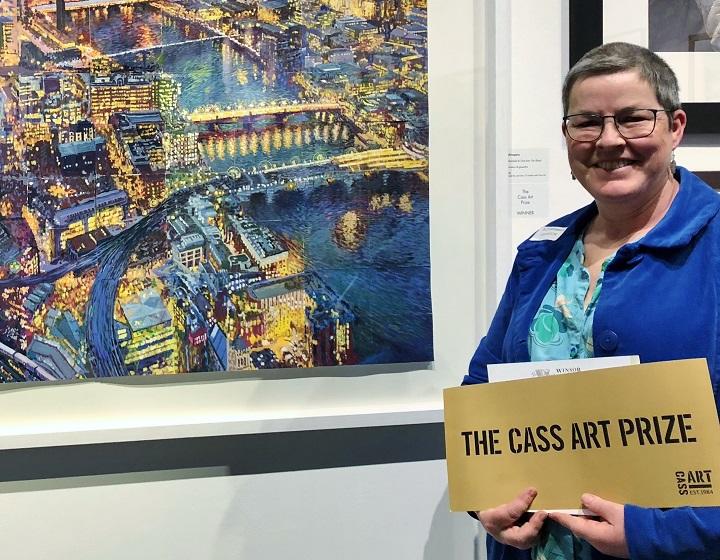
Your winning piece was chosen for its innovative use of colour. The piece is large, but made up of individual smaller sheets of watercolour paper, and the colour shifts slightly across the piece. Can you explain your process for creating this, and the concept?
I’m a very figurative painter and I harbour a secret dream to be more abstract…but I can’t do it. I guess everyone actually ends up painting in their own style however hard they try, so in order to satisfy that interest I often paint by splitting up my source material into small sections. Then all I can see is light and colour. I enjoy the way the colour shifts about, I think it’s to do with the mood I’m in when I’m painting, it could even be the weather.
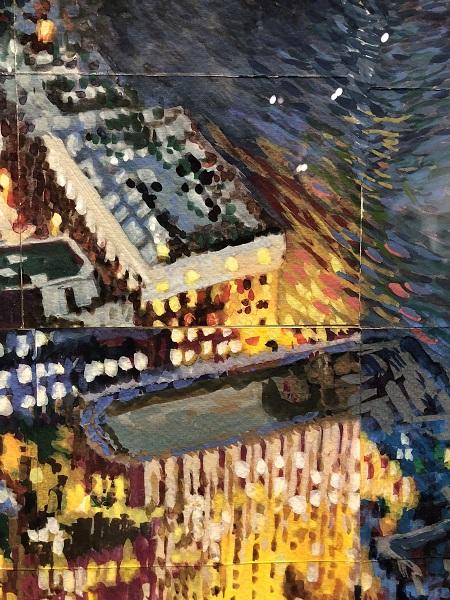
The two other reasons behind this are travel, I’ve been moving around quite a bit lately and I wanted to be able to transport what I was working on, so by working on small sections I could pop it all in a bag and work where ever I was. Obviously it wouldn’t be practical to work at the top of the Shard, so sometimes it’s necessary to use photographs to work from, in those cases I like to use deliberately bad photographs or, like this one, cut them up.
What do you enjoy most about watercolour?
I love the unpredictability of watercolour, it dries into a different shade, colours react against each other, there is far more alchemy with watercolour, it’s a huge challenge. I like rich saturated colour, that’s difficult to achieve with watercolour. ‘One Hundred to One from The Shard’ is made with gouache and watercolour, I usually throw watercolour over the gouache to ‘worry it up’ a bit. For years I used Winsor & Newton but now I mostly use Rembrandt watercolours. I’ve also experimented with making my own paints.

Is there a specific subject matter that you enjoy?
I paint a lot of gardens but now I am a bit obsessed with cities at night. I live in the depths of the Cornish countryside, so for me cities are very strange and exotic, it’s the light, I’m very drawn to the effects of light. I also like to paint the everyday mundane bits of life, a chair beside a window, a corner of an allotment.

You’re also a self-confessed compulsive sketchbook keeper. How important do you think it is to keep sketchbooks and how do they help your practice?
I love sketchbooks, I own some of my great-great grandfather’s sketchbooks and they’re like time traveling treasure. I use sketchbooks normally, like everyone else, full of sketches but I also make some into artworks. I take a theme and explore the theme in one sketchbook, usually Moleskine but I’m always looking for an alternative. Then after completing 29 double page spreads, I frame them in opening frames. It’s a bit like a very slow digital photo frame, you can open the frame and display a different painting every day. Painting in them is like a tightrope walk, the closer you get to the end the more nerve wracking it becomes, painting on both sides of each page I cant make a false move!

Do you have any tips and techniques for anyone starting out with watercolour?
Yes get yourself some good materials, you don’t need every colour under the sun but a good basic range, warm and cool of each colour, red, yellow and blue, then a couple of browns and about three good brushes. Good paper is also important, make sure it’s heavy enough, I always paint on 300 grams. Think of starting to paint like starting to go running, if you set out with a pair of plimsoles that cost a pound you are going to end up with very sore feet and I can guarantee that it would put you off running! If you are going to try something then get some good equipment…then practice, a lot, you will get better, but you have to put the hours in.
What are the other essential tools and materials in your studio?
I use a lot of Royal Talens paints and materials as they sponsor me as an artist. I have an absurd collection of paintbrushes, some very worn out but I can’t throw them away. I use Van Gogh oil paints as I got so used to their colours while working on the film ‘Loving Vincent’. I run workshops so I tend to have quite a lot of everything to use with students. I have some huge rolls of watercolour paper and a collection of antique artists’ equipment, mostly from my great-great grandfather.
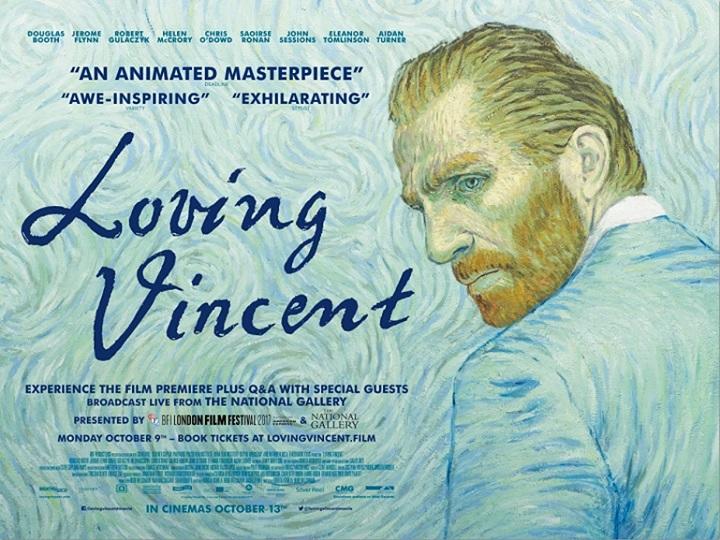
You were the only British artist to work on the first fully painted feature length film ‘Loving Vincent’ all about the life and mysterious death of Van Gogh. Each frame of the film was painted in Van Gogh’s signature painting style. Could you tell us a bit about that experience and how it all worked?
I saw the recruitment trailer on Facebook, it went viral with over 200 million views, they were asking for interest from artists who painted in oil colour so I sent them samples of my work, as did 5,000 other artists from all around the world and didn’t hear anything back, so I forgot all about it. Then several months later I had an email asking for a Skype conversation where they explained what would be involved in coming for a three-day test in the studio in Gdansk and asked if I was interested…of course I was! A couple of days later I was on a flight to Gdansk. They tested about 90 artists from everywhere, USA, Canada, Mexico, Australia, all over the world. It was hard, three days of learning the very basics of animation with oil paint, then we all went home with no idea of how we had done. About a week later 30 of us were invited back to begin the three-week training. I was doing an art fair with my glamorous assistant when I got the call, so we packed up our stand, drove to a supermarket and I brought a suitcase to put my weekend’s worth of art fair clothes in, he dropped me at an airport and we said good bye, for three weeks, or maybe five weeks… how naive was I! I didn’t see him or home again for five months!
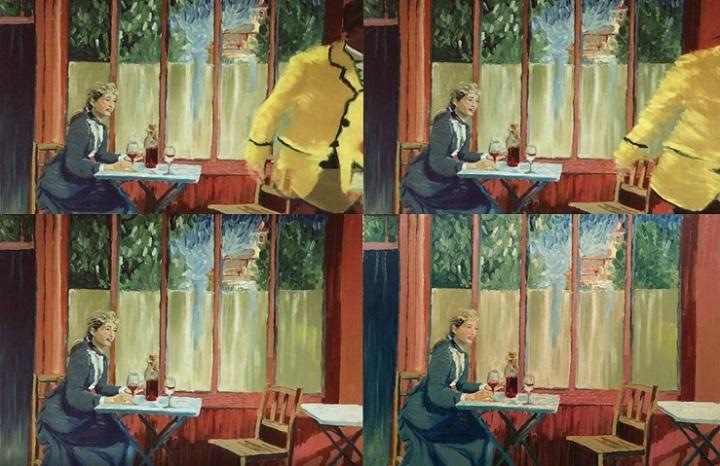
It was the most amazing experience, like a boot camp for artists, at times it was brutal, very tough getting through the training, long hours and very difficult to shed your own artistic style. Everyone was far from home and families, but it was also brilliant, a fantastic project to be involved in and it was wonderful to spend time with so many other artists, all with very different experiences of being an artist, it was fascinating.
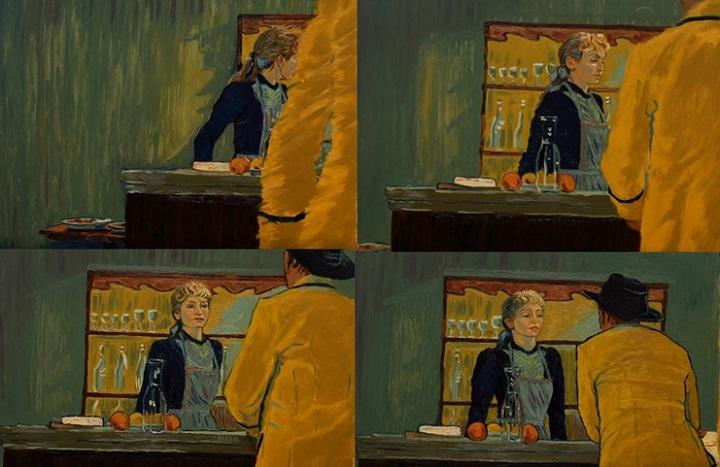
We worked alone in small light proof cubicles called PAWS, Painting Animation Work Stations, lit with halogen lamps to keep the light consistent for when we had to photograph each finished frame. The frames were painted on primed board and are about 70 x 100 cm or 27 x 40 inches. The actors were filmed on green screen with a few props that was then rotoscoped, or turned into a kind of line drawing. So you would get your shot projected onto your boards, frame by frame, so that acted as a guide for the figure’s movement. The picture would then be created combining the Van Gogh painting (that was the “set” for the action of your shot) with the actors and the actors had to be painted in the Van Gogh style but still maintaining their own looks, like a portrait. So, you would get the first frame painted, find and mix all the colours by eye, mixing enough colour to last for the whole shot, some as long as 300 frames, a process that could take from one day to five days depending on its complexity. Then you had to get the first frame signed off before you could begin animating. Which meant scraping off your beautiful painting, cleaning it back and replacing the brushstrokes, one by one in a slightly different position, then photographing the second frame and so on. Each day, every day. I averaged about four frames per day.
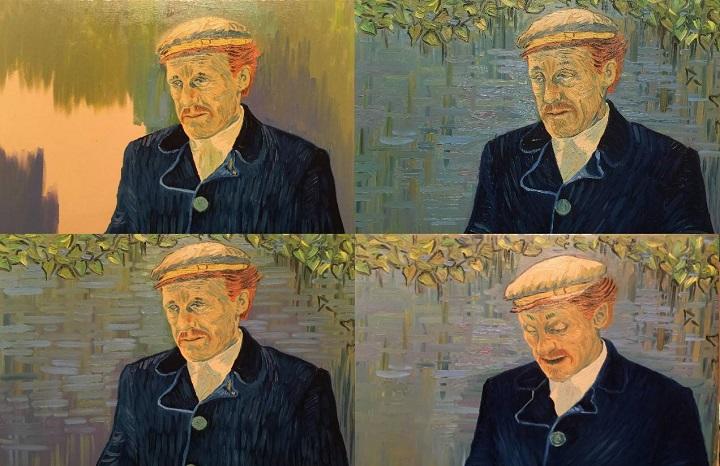
Has Vincent had a lasting impact on your work?
I love both the impressionists and the post impressionists, always have, becoming so immersed in the paintings of Van Gogh has only heightened my appreciation of those artists. What it has done is convince me of the benefits for all artists, whatever stage you are at, beginner or professional, of studying and copying work of artists that you are drawn to, it’s a fantastic way to learn and to practice your skills. I think that working on the film has improved my colour sense and my handling of paint, I think colour mixing is a lost art! I enjoy mixing colours and often make mixing charts just to relax! I love his energy and variety of mark making and the colours that he uses in his work.
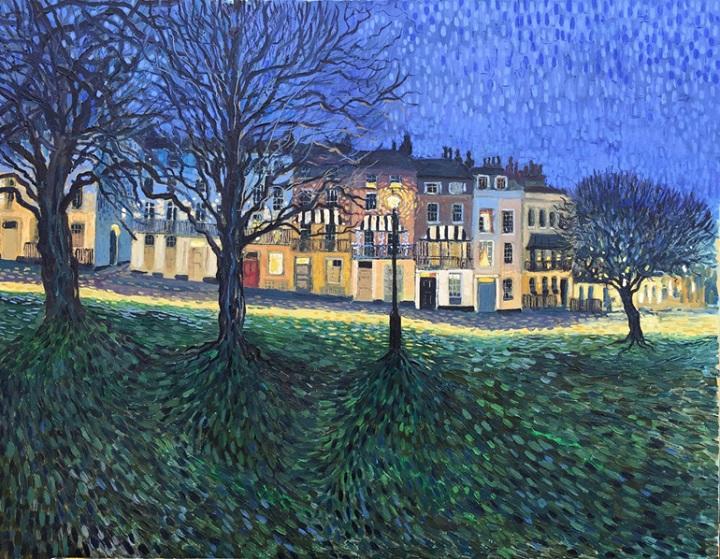
Which other artists both historical and contemporary inspire you?
Bonnard, Vuillard, John Singer Sargent, Joan Eardley, Thomas Paquette, David Hockney, Isaac Levitan, Nicholas Verrall, Andrew Wyeth.
What do you have coming up?
I’ve just made an advert with Cancer Research UK, painting Van Gogh’s sunflowers. I have a painting trip to Tuscany in September and a commission in Provence. I’m working on a series of night paintings and building another large London view. I’m also working on a series of painting books. I’m Artist Ambassador for Royal Talens and Artist Ambassador for Artlook Software. I run a series of workshops exploring Van Gogh’s style. Plus I am always on the look out for a good gallery.
Feeling inspired?
See Sarah’s winning work alongside members of the RI and other artists selected by the RI Council at the Mall Galleries until 21st April. Find out more here.
See more of Sarah’s work at www.sarahwimperis.co.uk, or follow her on Twitter @SarahWimperis, on Instagram @szwimperisart, or on Faceook @WimperisPaintings
Image credits: All artworks © Sarah Wimperis



